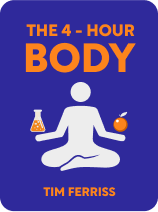

This article is an excerpt from the Shortform book guide to "The 4-Hour Body" by Timothy Ferriss. Shortform has the world's best summaries and analyses of books you should be reading.
Like this article? Sign up for a free trial here .
What is self-experimentation? Why is self-experimentation important for The 4-Hour Body lifestyle?
Self-experimentation is the process of testing strategies on yourself to find what works best for you and what you want. It is at the core of The 4-Hour Body.
Read more about self-experimentation and how to do it responsibly.
The Value of Self-Experimentation
Some scientists endorse self-experimentation. It has several advantages compared to conventional scientific research because it’s:
- Fast-paced. When you have an idea about how to improve some element of your life, you can quickly make a change and observe the results. A single scientific study, on the other hand, takes a long time to get started because it requires extensive funding, which is time-consuming to secure. Additionally, it takes it years after a study is completed for the research to be replicated and officially endorsed.
- For example, the Food and Drug Administration is 10 years behind published research and 20 years behind evidence.
- Unbiased. Self-experimentation can focus on simple solutions, such as diet or sleep, which have been around since the Stone Age. Conventional research tends to focus on more complicated solutions, such as drugs, because drug companies will fund this work.
- For example, dermatologists are focused on the use of drugs to improve acne, even though there’s compelling evidence that diet changes might improve it.
- Lead by people who are strongly motivated. Self-experimenters are motivated by the desire to improve their lives, which is a powerful driver. Conventional researchers, on the other hand, are usually motivated by other goals, such as keeping their jobs, regularly publishing papers, getting funding, or obtaining status.
- Far-reaching. Whenever you make a change to your lifestyle, you see corresponding changes in your body, some of which you might not have predicted. These changes can lead you to new discoveries and experiments.
- For example, Seth had been having trouble sleeping for years. When he changed what he ate for breakfast for unrelated reasons, he found that eating fruit instead of oatmeal made him sleep worse and that he slept better when he didn’t eat breakfast at all.
- Multi-disciplinary. As a self-experimenter, you can combine theories from different fields and take more factors into account than a narrow scientific study.
- For example, doctors never consult bodybuilders about the impacts of testosterone, and bodybuilders don’t always talk to doctors either. They could learn from each other, but they don’t, and the field of performance enhancement is held back.
Assessing the Validity of Scientific Research
You might think that scientific research would be free from the biases and inaccuracy of popular belief and marketing, but unfortunately, some studies aren’t legitimate. Additionally, the sources that publicize scientific results (like the media) sometimes have an agenda, and even if the science is solid, the reporting may skew it.
To find out what research actually shows, and if research is flawed, dig deeper when you come across the following:
1. Results that are relative rather than absolute. If a headline or study uses words like “longer” or “more,” or gives percentages rather than numbers, dig deeper. These are techniques to obscure results.
- For example, if you read a headline that says people who eat bananas lose 10% more fat, look at the actual numbers. 10% could be the difference between 90 and 100 pounds, or the difference between 0.09 and 0.1 pounds.
2. Results based on surveys or self-reporting when the reporting takes place after the fact. If a study relies on people remembering their habits, the data the participants provided might be inaccurate, since memory can be flawed. That doesn’t mean the study is completely useless, but it’s more relevant for broad strokes than specifics.
- For example, 194 people responded to a questionnaire about the Slow-Carb Diet (for more on this diet, see Chapter 4). The data isn’t perfectly accurate for two reasons: 1) people could have forgotten or made up their numbers, and 2) survivorship bias (the tendency of people who achieved positive results being more likely to respond) might have been in play. The questionnaires can, however, tell us that the diet works well for most people who follow the rules (failures were almost all due to people not following the instructions).
3. Results from observational studies. Observational studies look at groups of people outside a controlled environment, so there are many variables at play that may affect the results. The only thing an observational study can tell you is that two things might exist in one group at the same time, not that they necessarily have any cause or effect on each other (except when the numbers are massive, such as the twentyfold increase in lung cancer risk among smokers compared to non-smokers). Their only value is in helping researchers (or yourself) come up with ideas of what things might be related so that they can do a properly controlled test in a lab.
- For example, a 2004 observational study looked at a group of women who were using hormone replacement therapy (HRT). The women in this group had lower heart disease, and the study suggested that HRT was responsible. In fact, this was untrue—later studies found that HRT actually slightly increases the risk of heart disease.
4. Results of diet studies that claim to have used a control group. It’s very hard to change only one thing in a diet study because food is made up of many different elements. Self-experimentation is more valuable in these cases because the state of your body before you make a change is in your control, and you don’t need to know exactly what you changed to get the result—just that whatever you ate created results.
- For example, in a whole-food diet, when one group stops eating a fatty food, this will decrease both fat and protein in the diet, which in turn decreases calories. This change means that the control group and test group have at least three variables differentiating them: the amount of fat, protein, and calories they’re consuming. It’s impossible to know which variable will be responsible for the study’s results.
5. Results that are caused by randomness, not causation. All good scientific studies include a p-value, which indicates how likely it is that the results are simply random. Studies with a p-value of lower than 0.05 have results that are statistically significant—there’s a lower than 5% chance that they’re random. There are three things to keep in mind about p-values:
- Remember that chance can explain a lot. For example, at a party with 23 attendees, there’s a 50% chance that two people have the same birthday.
- Small sample sizes are okay if the differences in results are large. For example, if changing a controlled variable triples an effect, you don’t need to test it on very many people to show that the change is significant.
- Combining p-values of multiple experiments invalidates the accuracy of the p-value. Scientists sometimes do this if they’re trying to make their results match their agenda, so it’s important to watch out for.
6. Results funded by organizations with an agenda. Sometimes, organizations that fund studies want a particular result that will benefit them, and to maintain funding, scientists will skew the data to achieve this result. Skewing the data ranges from comparing the drug to a placebo (as the placebo does nothing, the drug is almost guaranteed to have better results than it), only generally and vaguely asking about side effects, or leaving out negative results. To find out who funded a study, read the “conflicts of interest” section, and look for notes about consulting fees.
- For example, researcher James Hill’s work about the relationship between high sugar consumption and obesity is funded by corporations who make high-sugar foods. Hill is attempting to show that sugar doesn’t lead to obesity.

———End of Preview———
Like what you just read? Read the rest of the world's best book summary and analysis of Timothy Ferriss's "The 4-Hour Body" at Shortform .
Here's what you'll find in our full The 4-Hour Body summary :
- How to do the least amount you need to do for the results you want
- Why you need a cheat day in your diet
- How to improve everything about your body, including sleep, sex, and longevity






